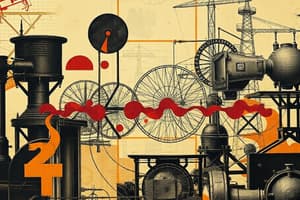Podcast
Questions and Answers
What does the First Law of Thermodynamics state?
What does the First Law of Thermodynamics state?
- Energy can be created or destroyed.
- Heat cannot flow spontaneously from a colder body to a hotter body.
- The change in internal energy equals heat added minus work done on the system. (correct)
- The total energy of an isolated system is constant.
Which type of thermodynamic process occurs at constant volume?
Which type of thermodynamic process occurs at constant volume?
- Isothermal
- Isochoric (correct)
- Isobaric
- Adiabatic
What is the primary focus of the Second Law of Thermodynamics?
What is the primary focus of the Second Law of Thermodynamics?
- Entropy in an isolated system tends to decrease.
- Energy transformations can be 100% efficient.
- Heat cannot spontaneously flow from a colder body to a hotter body. (correct)
- Heat will spontaneously flow from hot to cold.
What terms describe a system that can exchange both energy and matter with its surroundings?
What terms describe a system that can exchange both energy and matter with its surroundings?
Which of the following describes heat transfer through direct contact between materials?
Which of the following describes heat transfer through direct contact between materials?
Flashcards are hidden until you start studying
Study Notes
Thermodynamics
-
Definition: Branch of physics that deals with heat, work, temperature, and the statistical behavior of particles in a system.
-
Laws of Thermodynamics:
- Zeroth Law: If two systems are in thermal equilibrium with a third system, they are in thermal equilibrium with each other. Establishes the concept of temperature.
- First Law: Energy cannot be created or destroyed, only transformed. The change in internal energy (ΔU) equals heat added (Q) minus work done (W) on the system: ΔU = Q - W.
- Second Law: Heat cannot spontaneously flow from a colder body to a hotter body. Introduces the concept of entropy (S), which tends to increase in isolated systems.
- Third Law: As temperature approaches absolute zero (0 Kelvin), the entropy of a perfect crystal approaches a constant minimum.
-
Key Concepts:
- System and Surroundings:
- System: The part of the universe being studied.
- Surroundings: Everything outside the system.
- Types of Systems:
- Isolated: No exchange of energy or matter.
- Closed: Exchange of energy, but not matter.
- Open: Exchange of both energy and matter.
- State Functions: Properties that depend only on the state of the system, such as pressure, volume, temperature, and internal energy.
- Processes:
- Isothermal: Constant temperature.
- Adiabatic: No heat exchange.
- Isochoric: Constant volume.
- Isobaric: Constant pressure.
- System and Surroundings:
-
Heat Transfer:
- Conduction: Transfer of heat through direct contact.
- Convection: Transfer of heat by the movement of fluids.
- Radiation: Transfer of heat through electromagnetic waves.
-
Thermodynamic Cycles: Series of processes that return a system to its initial state (e.g., Carnot cycle, refrigeration cycle).
-
Entropy:
- Measures the disorder of a system.
- Higher entropy indicates higher disorder and energy dispersion.
- Important for understanding irreversible processes.
-
Applications:
- Power generation (e.g., heat engines).
- Refrigeration and air conditioning systems.
- Biological systems and metabolic processes.
Thermodynamics
- Definition: The study of heat, work, temperature, and how these interact with the statistical behavior of particles within a system.
- Laws of Thermodynamics:
- Zeroth Law: Two systems in thermal equilibrium with a third system are also in equilibrium with each other. This establishes the concept of temperature as a measure of this equilibrium.
- First Law: Energy cannot be created or destroyed, only transformed. The change in a system's internal energy (ΔU) is equal to the heat added (Q) minus the work done by the system (W): ΔU = Q - W.
- Second Law Heat cannot spontaneously flow from a cold object to a hot object. This introduces the concept of entropy (S), which naturally increases in isolated systems.
- Third Law: As the temperature of a perfect crystal approaches absolute zero (0 Kelvin), the entropy of the system also approaches a minimal constant level.
- Key Concepts:
- System and Surroundings: The system is the part of the universe being studied, while the surroundings encompass everything else.
- Types of Systems: Different systems can be classified based on their interaction with the surroundings:
- Isolated: No exchange of energy or matter with the surroundings
- Closed: Exchanges energy with the surroundings but not matter
- Open: Exchanges both energy and matter with the surroundings
- State Functions: These properties solely depend on the current state of the system and include variables like pressure, volume, temperature, and internal energy.
- Processes: These relate to changes in the state of a system:
- Isothermal: Occurs at a constant temperature
- Adiabatic: No heat exchange takes place
- Isochoric: Occurs at a constant volume
- Isobaric: Occurs at a constant pressure
- Heat Transfer:
- Conduction: Heat transfer through direct contact between objects
- Convection: Heat transfer through the movement of fluids (liquids or gases)
- Radiation: Heat transfer through electromagnetic waves
- Thermodynamic Cycles: A series of processes that return a system to its initial state. Examples include the Carnot cycle (used in theory) and refrigeration cycles.
- Entropy (S): A measure of disorder or randomness within a system. High entropy indicates greater disorder and energy dispersion. It plays a critical role in understanding irreversible processes.
- Applications:
- Power generation: Energy conversion using heat engines (e.g., burning fuel to create electricity)
- Refrigeration and air conditioning systems: Cooling processes based on thermodynamic principles
- Biological systems and metabolic processes: Thermodynamics plays a key role in the functioning of living organisms and chemical reactions within them
Studying That Suits You
Use AI to generate personalized quizzes and flashcards to suit your learning preferences.




